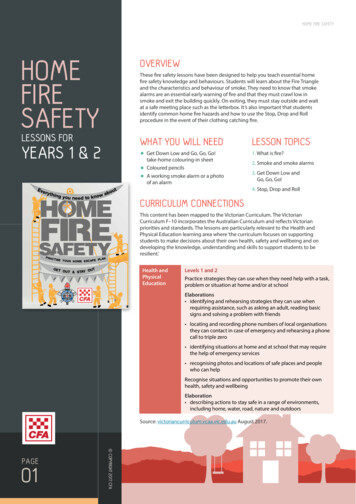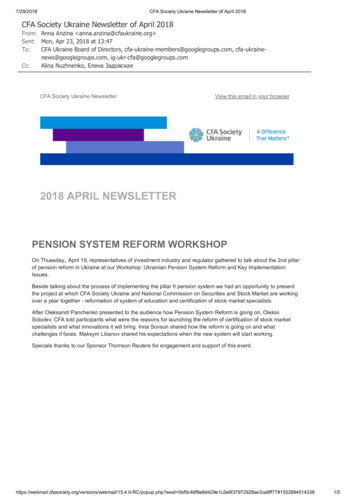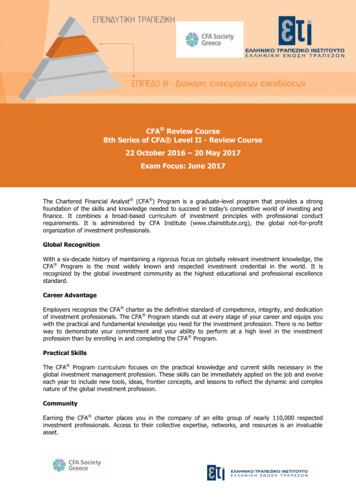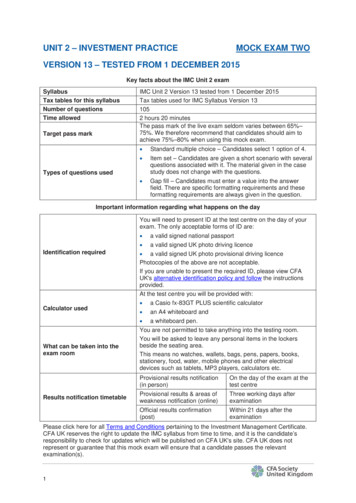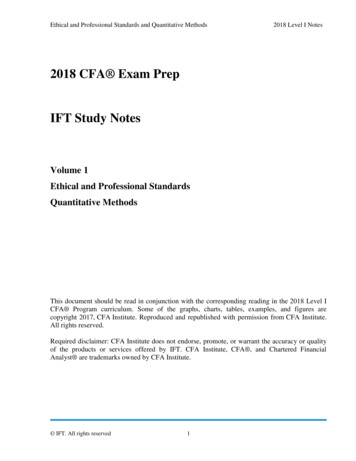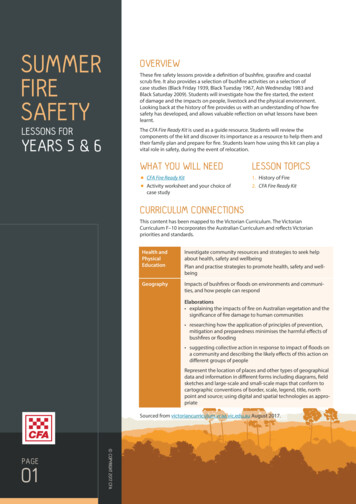
Transcription
SUMMERFIRESAFETYOVERVIEWThese fire safety lessons provide a definition of bushfire, grassfire and coastalscrub fire. It also provides a selection of bushfire activities on a selection ofcase studies (Black Friday 1939, Black Tuesday 1967, Ash Wednesday 1983 andBlack Saturday 2009). Students will investigate how the fire started, the extentof damage and the impacts on people, livestock and the physical environment.Looking back at the history of fire provides us with an understanding of how firesafety has developed, and allows valuable reflection on what lessons have beenlearnt.LESSONS FORThe CFA Fire Ready Kit is used as a guide resource. Students will review thecomponents of the kit and discover its importance as a resource to help them andtheir family plan and prepare for fire. Students learn how using this kit can play avital role in safety, during the event of relocation.YEARS 5 & 6WHAT YOU WILL NEEDLESSON TOPICSCFA Fire Ready Kit1. History of FireActivity worksheet and your choice ofcase study2. CFA Fire Ready KitCURRICULUM CONNECTIONSThis content has been mapped to the Victorian Curriculum. The VictorianCurriculum F–10 incorporates the Australian Curriculum and reflects Victorianpriorities and standards.Health andPhysicalEducationInvestigate community resources and strategies to seek helpabout health, safety and wellbeingGeographyImpacts of bushfires or floods on environments and communities, and how people can respondPlan and practise strategies to promote health, safety and wellbeingElaborations explaining the impacts of fire on Australian vegetation and thesignificance of fire damage to human communities researching how the application of principles of prevention,mitigation and preparedness minimises the harmful effects ofbushfires or flooding suggesting collective action in response to impact of floods ona community and describing the likely effects of this action ondifferent groups of peopleRepresent the location of places and other types of geographicaldata and information in different forms including diagrams, fieldsketches and large-scale and small-scale maps that conform tocartographic conventions of border, scale, legend, title, northpoint and source; using digital and spatial technologies as appropriateSourced from victoriancurriculum.vcaa.vic.edu.au August 2017.01 COPYRIGHT 2017 CFAPAGE
SUMMERFIRESAFETYBUSHFIRES – A CASE STUDY60 MINUTESMaterialActivity worksheet and your choice of case study.Explain the following points:A bushfire is a freely, burning, uncontrolled and unplanned fire, which needsto be extinguished especially if it is threatening houses or people.Bushfires happen mostly during hot, dry, weather and can be caused by drylightning storms, fallen power-lines or human activity such as – out-of-controlcampfires, sparking angle grinders or firebugs (arson).LESSONS FORYEARS 5 & 6A grassfire is a fire that burns quickly through fine fuel.A coastal scrub fire is a very hot, fast moving and erratic fire that is fanned byocean winds.ActivityHand out copies of the Activity worksheet and your choice of case study, andhave students answer the questions provided. Alternatively, they can chooseto conduct their own research of any major Australian fire if they have access toonline resources.After students have completed the questions, ask them how fires in Australianhistory have helped us become more fire aware. What have we learnt from them?Suggested further activityStudents create a social media campaign on promoting bushfire awarenesswithin their local communities. Again, using the context most appropriate toyour surroundings - bushfire, grassfire or coastal scrub fire. The campaign shouldinclude details on fire danger signs, how to prepare their home and propertyearly, as well as having a Bushfire Survival Plan. Students should aim to describehow these prevention, preparedness and mitigation actions can minimise theharmful effects of bushfire on the community.02 COPYRIGHT 2017 CFAPAGE
SUMMERFIRESAFETYCFA FIRE READY KIT60 MINUTESMaterialsCFA Fire Ready KitAsk students to answer the following questions using information providedin the CFA Fire Ready Kit.Go through the CFA Fire Ready Kit together as a class. Explain that it has been puttogether with important fire safety topics and planning documents.LESSONS FOR1. Which Fire Weather District do you live in?YEARS 5 & 62. Which type of environment do you live in? What can you expect?3. How to Plan. What are some of the ten key decisions you should discuss withyour family before the fire season?4. What should an emergency kit contain?5. What is radiant heat and how do you protect yourself against it?6. What is the difference between the Fire Danger Rating and Total Fire Ban sign?What does each sign tell us?7. What is ember attack?8. Preparing your property. What are some of the things you can do to prepareyour property?Suggested further activities1. Download the bushfire survival planning template - Leaving early atcfa.vic.gov.au and complete it at home with your family.2. Visit and explore the VicEmergency website at emergency.vic.gov.auYou can also download the VicEmergency app to your smartphone.03 COPYRIGHT 2017 CFAPAGE
SUMMER FIRE SAFETYTHE BLACK TUESDAY BUSHFIRES(TASMANIA 1967)On February 7, 1967, Tasmania experienced theworst bushfires they had ever had, resulting in thehighest numbers of lives lost and greatest damage toTasmanian communities.The weather was extremely hot and dry in earlyFebruary due to the early onset of summer. Severalbushfires had already started across different areas ofTasmania.The vegetation had already dried out due to acontinuing drought. Green vegetation was minimal.The first of the fires broke out in Southern Tasmania.Fires then raged across large areas including areas:Hamilton, Bothwell, D’Entrecasteaux Channel and Snug.It was concluded that some of the fires weredeliberately lit for the purpose of burning off. Laterinvestigation found that out of 110 fires that happened,only 22 were accidental.In the aftermath, in the town of Snug,a memorial for the bushfires wasbuilt. A plaque listing the names ofthose who lost their lives in the firewas inscribed and placed on a brickchimney.Bushfire readiness information is alsoincluded on the memorial.IMPACTED AREATOTAL DAMAGELoss of life62Livestock lost62,000Injuries9,000Left homeless7,000Financial 40 millionDestroyed land2,640 square kmOTHER DAMAGEEnvironmentForest and over 100 public structuresVehicles1500Bridges80Power lines4,800PAGEARE YOU FIRE READY?04
SUMMER FIRE SAFETYACTIVITY WORKSHEET – THE BLACK TUESDAY BUSHFIRESUsing the case study on The Black Tuesday Bushfires (Tasmania 1967), provide your answers to thefollowing questions:01 Describe the weather conditions leading up to and on the day of the disaster.02 How did the bushfires start?03 What effect would burnt out bridges, cars and a loss of power have on a community?04 Describe the characteristics of the bushfire.Consider the type of fire, the size of the fire and how many occurred at the same time?05 What damage was caused?Consider the impact to people, livestock, the physical environment such as structural damage to the propertyas well as the impact on our natural environment.06 Why is it important to build memorials after a disaster like Black Tuesday?Research another memorial constructed after a major bushfire and present your findings to the class.07 Research how long it took the natural environment to regrow after the Black Tuesday Bushfires.Find out how Australian plants have adapted to living with fire.PAGEARE YOU FIRE READY?05
SUMMER FIRE SAFETYACTIVITY WORKSHEET – THE BLACK TUESDAY BUSHFIRESANSWER SHEET01 Describe the weather conditions leading up to and on the day of the disaster.The weather was extremely hot and dry in early February due to the early onset of summer.02 How did the bushfires start?It was concluded that some of the fires were deliberately lit for the purpose of burning off. Later investigation foundthat out of 110 fires that happened, only 22 were accidental.03 What effect would burnt out bridges, cars and a loss of power have on a community?Burnt out bridges and cars would make it difficult for people to move around and do things like buy food. A loss ofpower would mean they might not be able to cook, have hot water, have lights or electric heating or cooling.04 Describe the characteristics of the bushfire.Consider the type of fire, the size of the fire and how many occurred at the same time?The110 fires that burned on Black Tuesday affected 2,640 square kilometres of land.05 What damage was caused?Consider the impact to people, livestock, the physical environment such as structural damage to the propertyas well as the impact on our natural environment.Sixty-two human lives were lost, 9,000 were injured and 7,000 people were left homeless in the Black Tuesday Fires.Eighty bridges, 1500 vehicles and 4,800 powerlines were damaged or destroyed as well as 100 public structures.06 Why is it important to build memorials after a disaster like Black Tuesday?Research another memorial constructed after a major bushfire and present your findings to the class.Building memorials helps us remember the lives lost and keeps fire safety in our minds. If the community is involved italso helps them with the healing process.07 Research how long it took the natural environment to regrow after the Black Tuesday Bushfires.Find out how Australian plants have adapted to living with fire.Research this online through both Black Tuesday and Australian vegetation websites.PAGEARE YOU FIRE READY?06
SUMMER FIRE SAFETYTHE ASH WEDNESDAY BUSHFIRES(VICTORIA & SOUTH AUSTRALIA 1983)Between April 1982 and January 1983, Victoria wasexperiencing severe drought conditions and littlerainfall, resulting in its driest period on record. On the16th of February, a combination of dry grasslands andforests, very hot temperatures, low humidity and highwind gusts presented Victoria with a high bushfire risk.The temperature soared to 43 degrees Celsius on AshWednesday.Around 180 bushfires began on 16 February 1983.The largest bushfires started in Victoria at Cudgeeand Branxholme (near Warrnambool); around MountMacedon; in the Dandenong Ranges; in Warburtonand the Otways. Fires also broke out in South Australia,where 159,000 hectares of land in the Adelaide Hills andfarming country in the south east of the state were razed.The bushfires started in a number of ways includingpower lines and arson (fires being deliberately lit). TheVictorian fires burnt an area almost twice the size ofmetropolitan Melbourne, around 200,000 hectares anda huge number of people lost their homes, possessions,stores, equipment, machinery and stock.Fire burns towardsthe AustralianEmergencyManagementInstitute (AEMI),Mount Macedon.Photo by: A Davis Australian EmergencyManagementInstituteIMPACTED AREATOTAL DAMAGELoss of life75Livestock lost340,000 sheep and 18,000 cattleInjuries2,676Financial 400 million (around 1.3 billion today)Destroyed land210,000 hectaresThe majority of the Ash Wednesday fires were broughtunder control by the end of the day. Some fires tooktwo to eight hours to control, while others took acouple of days. Accessibility to the fires played a largepart in how quickly fires were brought under control.Fires in mountainous areas were often more difficult toput out due to difficulties in moving the fire vehiclesin close enough to the fires. In some areas, there wasno road access into the fire. The fine fuelsin grasslands burned quickly while theforested areas burnt slower, but for longer,and were much hotter. Both these fire typesare hard to control.OTHER DAMAGEEnvironment82,500 hectares of public land and over 127,500 hectaresof private land burned in Victoria and South AustraliaStructures3700 buildings including 2400 homes (2,000 in Victoria)ARE YOU FIRE READY?A study was conducted into the 32 people(excluding firefighters) who died in Victoria.It showed that 25 were outside their homesand several of them died in vehicles whiletrying to escape. It was found that delayingleaving until the last minute was a commoncause of death.PAGE07
SUMMER FIRE SAFETYACTIVITY WORKSHEET – THE ASH WEDNESDAY BUSHFIRESUsing the case study on The Ash Wednesday Bushfires (Victoria and South Australia 1983), provide answers to thefollowing questions:01 What are the four things that presented Victoria with a high fire risk on Ash Wednesday?02 How do you think powerlines could start a fire? How could this be prevented?03 Why did some of the fires take so long to control? Why are forest fires hard to control? Why are grassfires hardto control?04 What damage was caused by the fires?Think about the impact to human and animal life as well as the damage to buildings and the naturalenvironment.05 More than 200,000 hectares was burnt in Victoria and South Australia during the Ash Wednesday Fires. If theMelbourne Cricket Ground (MCG) is around 2 hectares – how many times bigger was the area affected by thefires?06 What was considered a common cause of death in the fires? What message are we now given if we knowthere is a high risk of bushfire?PAGEARE YOU FIRE READY?08
SUMMER FIRE SAFETYACTIVITY WORKSHEET – THE ASH WEDNESDAY BUSHFIRESANSWER SHEET01 What are the four things that presented Victoria with a high fire risk on Ash Wednesday?Drought dried out grasslands and forests, very hot temperatures, low humidity and high winds presented Victoria witha high bushfire risk.02 How do you think powerlines could start a fire? How could this be prevented?Powerlines hitting each other due to high winds or branches can cause sparks. Burying powerlines or making sure treesare trimmed clear of them can help prevent fires.03 Why did some of the fires take so long to control? Why are forest fires hard to control? Why are grassfires hardto control?Fires in mountainous areas were often more difficult to put out due to difficulties in moving the fire vehicles in closeenough. In some areas, there was no road access into the fire. Some of the fires were also along the coastal scrub areas.Fires in forested areas are hard to control because they burn hot and for a long time due to the amount of the fuel.Grassfires move very quickly making them hard to control.04 What damage was caused by the fires?Think about the impact to human and animal life as well as the damage to buildings and the naturalenvironment.Seventy-five people died and 2,646 were injured. 358,000 sheep and cattle were lost and 520,000 hectares of land wasaffected. 3700 buildings including houses and outbuildings such as sheds were also lost in the fires.05 More than 200,000 hectares was burnt in Victoria and South Australia during the Ash Wednesday Fires. If theMelbourne Cricket Ground (MCG) is around 2 hectares – how many times bigger was the area affected by the fires?The area of the fire was 100,000 bigger than the MCG.06 What was considered a common cause of death in the fires? What message are we now given if we knowthere is a high risk of bushfire?Delaying leaving until the last minute before the fire arrived was a common cause of death. We are now told if we planto leave, we should leave early.PAGEARE YOU FIRE READY?09
SUMMER FIRE SAFETYTHE BLACK FRIDAY BUSHFIRES(VICTORIA 1939)In early 1939, several years of drought had causedVictoria to be extremely dry and ready for fire. Severalfires had started in early December the previousyear and continued to burn through January. On 13January 1939, on what became known as Black Friday,several fires joined into a massive front that spreadalong the coast south west of Melbourne and acrossmountainous north-east Victoria killing 36 people andburning huge tracts of land.In the week leading up to Black Friday, several fires werealready burning and around 75 per cent of Victoria wasaffected by fire. Many bushmen and graziers, thinkingthey would protect themselves from the oncomingblaze, set fire to the bush and grassland. With the hot,dry conditions these fires quickly got out of control andadded to the huge fire fronts that would follow. Threedays before Black Friday, the majority of the mountainash forest that makes up the Great Dividing Range wasablaze.The Glen GuestHouse at WestHealesville,destroyed by theBlack Friday firesCourtesy ofDepartment ofEnvironment andPrimary Industries,VictoriaThe scene of destruction at Omeofollowing the Black Friday bushfiresCourtesy of Department of Environmentand Primary Industries, VictoriaIMPACTED AREATOTAL DAMAGELoss of life36 (71 total over January 1939)Financial 750 million (estimated)Destroyed land2,000,000 hectaresOTHER DAMAGEEnvironment575,000 hectares of reserved forest and780,000 forested Crown land destroyedStructuresApproximately 1300 buildings lost. Morethan 1000 homes, 69 sawmills, manybusinesses, farms and other buildings.When Black Friday came, the temperature soared to45.6ºC in Melbourne. The hot dry conditions that hadpreviously dried out the vegetation made the humiditylevels (the amount of moisture in the air) very low. This,coupled with strong northerly winds, made the firesextremely dangerous and difficult to control. In the firesthat followed, many towns, such as Warrandyte (nowa suburb of Melbourne) were badly damaged. Others,such as, Narbethong, Noojee, Woods Point, NayookWest and Hill End were completely destroyed. Somewere never rebuilt.These were the second largest fires the state has everknown (the largest being Black Thursday 1851). A RoyalCommission headed by Judge Stretton found the causeof the fires to be due mainly to ‘careless burning’, sayingthe fires were ‘lit by the hand of man’. Many of therecommendations of the inquiry, such as the buildingof fire towers, the making of fire trails and controlledburning, are still in use today. The creation of CFA in1944 was, in part, due to this disaster.PAGEARE YOU FIRE READY?010
SUMMER FIRE SAFETYACTIVITY WORKSHEET – THE BLACK FRIDAY BUSHFIRESUsing the case study on The Black Friday Bushfires (Victoria 1939), provide answers to the following questions:01 What was the main cause of the Black Friday Bushfires?02 How do strong winds affect a bushfire?03 Compare the Black Friday Fires (2,000,000 hectares burnt, 36 lives lost) to the more recent 2009 BlackSaturday Fires (450,000 hectares burnt, 173 lives lost). Why were there more lives lost in 2009 when less landwas affected?04 What did Judge Stretton mean when he said the fires were ‘lit by the hand of man’?05 What were four of the important measures that came out of the Black Friday Bushfires?06 What is one thing we do now on high fire danger days to stop people lighting fires outdoors?PAGEARE YOU FIRE READY?011
SUMMER FIRE SAFETYACTIVITY WORKSHEET – THE BLACK FRIDAY BUSHFIRESANSWER SHEET01 What was the main cause of the Black Friday Bushfires?Bushmen and graziers set fires to protect themselves which got out of control in the bad conditions.02 How do strong winds affect a bushfire?Strong winds fan the flames of a bushfire (by adding oxygen).03 Compare the Black Friday Fires (2,000,000 hectares burnt, 36 lives lost) to the more recent 2009 BlackSaturday Fires (450,000 hectares burnt, 173 lives lost). Why were there more lives lost in 2009 when less landwas affected?There were more people living in, or near, bush areas in 2009 compared to 1939.04 What did Judge Stretton mean when he said the fires were ‘lit by the hand of man’?Judge Stretton meant that people lit the fires.05 What were four of the important measures that came out of the Black Friday Bushfires?Four important measures that came after the Black Friday Bushfires were fire towers, fire trails, controlled burning andthe creation of CFA.06 What is one thing we do now on high fire danger days to stop people lighting fires outdoors?On hot summer fire days we have Total Fire Bans where no fires can be lit in an open area.PAGEARE YOU FIRE READY?012
SUMMER FIRE SAFETYTHE BLACK SATURDAY BUSHFIRES(VICTORIA 2009)On February 7, 2009, Victorians awoke to what wasto be the hottest day on record (46.4 C recorded inMelbourne). After three consecutive days above 43 Cthe bush was tinder dry.On the previous day, the then Premier John Brumbyhad issued a warning that it was to be the ‘worst dayof fire conditions in the history of the state’ and peopleneeded to ‘exercise real common sense tomorrow.’ Hewas to be proved right.Fires around Taggerty, Feb 2009IMPACTED AREATOTAL DAMAGELoss of life173Livestock lostOver 11,800 head of livestockWildlife lossapprox. 1 million animalsInjuries414Left homeless7,562 people displacedFinancial 4.4 billionDestroyed land450,000 hectares burntOTHER DAMAGEEnvironmentNearly 100,000 hectares of parksdamagedAgricultural loss62,000 hectares of grazing pasture, and32,000 tonnes of hay and silageBusiness lossOver 55 businesses destroyedElectricitySupply disrupted to 60,000 residentsStructuresOver 3,500 (houses, sheds, commercialand community buildings)ARE YOU FIRE READY?By mid morning fierce northwesterly winds, greaterthan 100 kilometres per hour, were fanning fires thathad begun days earlier in Central Gippsland and BunyipState Park. Then, before midday, powerlines fell inKilmore East. It was the beginning of what becameknown as the Kilmore East Fire – a series of fires thatraged across the dry mountain ash forests of theKinglake Ranges – finally meeting with the Murrundindifire. Several other bushfires also burned across thestate including those fires in Bendigo, Bunyip, Churchill,Dargo and Beechworth. In all, around 400 separatefires were recorded on the day. Some of these weresuspected to be arson (deliberately lit fires).Black Saturday became Australia’s worst fire disaster,claiming 173 human lives and directly affecting over78 communities. More than 19,000 CFA members wereinvolved in frontline firefighting, incident managementand support.In the aftermath of Black Saturday, people in Australiaand around the world donated over 400 million dollarsand mountains of goods and clothing to help thesurvivors.Further 13
SUMMER FIRE SAFETYACTIVITY WORKSHEET – THE BLACK SATURDAY BUSHFIRESUsing the case study on The Black Saturday Bushfires (Victoria 2009), provide your answers to thefollowing questions:01 What do you think Premier John Brumby meant when he said people should ‘exercise real common sensetomorrow’? Think about what you have learned about ‘common sense’ in bushfire survival planning.02 Describe the weather conditions leading up to, and on the day of, the disaster. How do you think this affectedwhat happened on Black Saturday?03 How did the Kilmore East fire start? Why do you think it spread so quickly?04 What could be done to prevent fires like that at Kilmore East from occurring in the future?05 What damage was caused by the fires? Think about the impact to human and animal life as well as thedamage to buildings and the natural environment.06 What was the response of Australians and people overseas to the crisis? Why do you think they responded insuch a way?Research opportunityUsing the links below find out how the natural environment recovered from the fires. What does this tell us aboutthe Australian er-the-firesPAGE014
SUMMER FIRE SAFETYACTIVITY WORKSHEET – THE BLACK SATURDAY BUSHFIRESANSWER SHEET01 What do you think Premier John Brumby meant when he said people should ‘exercise real common sensetomorrow’? Think about what you have learned about ‘common sense’ in bushfire survival planning.John Brumby meant we should carry out our fire plan – if we were going to leave, we should leave early and if we weregoing to stay and defend, we should be prepared.02 Describe the weather conditions leading up to, and on the day of, the disaster. How do you think this affectedwhat happened on Black Saturday?There were three days over 43 C and the day itself was 46.4 C. The bush was very dry and there were strong winds. Thiscaused the fires to spread quickly and burn very hot.03 How did the Kilmore East fire start? Why do you think it spread so quickly?The Kilmore East Fire was caused by falling powerlines. The strong wind, low humidity and dry vegetation caused it tospread quickly.04 What could be done to prevent fires like that at Kilmore East from occurring in the future?Burying powerlines could prevent similar fires but this is very expensive.05 What damage was caused by the fires? Think about the impact to human and animal life as well as thedamage to buildings and the natural environment.One hundred and seventy three lives were lost in the Black Saturday fires, with 414 others documented as injured. Over11,800 livestock were killed and 1 million wild animals. 450,000 hectares of land were burnt, 3,500 structures were lostand over 55 businesses were destroyed.06 What was the response of Australians and people overseas to the crisis? Why do you think they responded insuch a way?People donated over 400 million dollars and a great amount of clothing and other goods. They felt sorry for thepeople who had lost so much. Many Australians understand the damaging power of bushfires.PAGEARE YOU FIRE READY?015
02 COPYRIHT 2017 CFA SUMMER FIRE SAFETY YEARS 5 & 6 LESSONS FOR BUSHFIRES – A CASE STUDY 60 MINUTES Material Activity worksheet and your choice of case study. Explain the following points: A bushfire is a freely, burning, uncontrolled and unplanned fire, which needs to be extin

